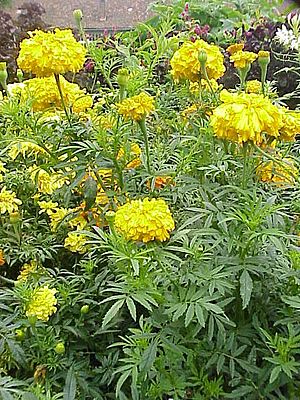Aztec marigold facts for kids
Quick facts for kids Aztec marigold |
|
|---|---|
 |
|
| Scientific classification | |
| Genus: |
Tagetes
|
| Species: |
erecta
|
The Aztec marigold, also known as the Mexican marigold or big marigold, is a beautiful flowering plant. Its scientific name is Tagetes erecta. In Mexico, it's called cempazúchitl or cempasúchil. Even though it comes from the Americas, some people call it the African marigold.
This plant is native to Mexico. You can find it growing wild in Mexican states like México, Michoacán, Puebla, and Veracruz. Aztec marigolds can grow to be about 20 to 90 centimeters (8 to 35 inches) tall. Long ago, the Aztecs collected these wild plants and also grew them. They used them for medicine, special ceremonies, and as decorations. Today, many types of Aztec marigolds are grown all over the world as ornamental plants for gardens and for making cut-flower bouquets.
Some experts believe that Tagetes patula, also known as the French marigold, is actually the same species as Tagetes erecta.
Contents
What Does It Look Like?
The Aztec marigold is a plant that usually lives for one year, but sometimes it can live longer. It grows from 30 to 110 centimeters (12 to 43 inches) tall. Its root is like a cylinder with many small, shallow branches. The stem is usually smooth and can be soft or slightly woody. It has special channels that hold a fragrant resin.
The leaves grow opposite each other at the bottom of the plant and then alternate higher up. They can be up to 20 centimeters (8 inches) long. Each leaf is made up of 11 to 17 smaller leaflets. These leaflets are shaped like spears, up to 5 centimeters (2 inches) long and 1.5 centimeters (0.6 inches) wide. They have jagged edges and many small, round glands.
The flowers are the most special part! They grow in small clusters or sometimes as single flowers on long stems, up to 15 centimeters (6 inches) long. The flowers are usually yellow to red. In simple flower heads, there can be 150 to 250 tiny flowers. In double flower heads, many of these tiny flowers change into larger, colorful petals. These petals are yellow to orange and about 8 to 10 millimeters (0.3 to 0.4 inches) long.
After the flowers, the plant produces long, thin seeds, about 7 to 10 millimeters (0.3 to 0.4 inches) long. The Aztec marigold blooms for a long time, all through summer and fall. It's very easy to grow new plants from its seeds.
Where Does It Grow?
Even though the Aztec marigold is originally from Mexico, you can also find it in many countries in Central America and the Caribbean. These include Belize, Bolivia, Colombia, Costa Rica, Cuba, Ecuador, El Salvador, Guatemala, Guyana, Honduras, Jamaica, Nicaragua, Panama, Puerto Rico, and Venezuela.
In the wild, these plants grow in different types of natural areas. They can be found in tropical forests, thorny forests, cloud forests, and pine-oak forests. They often grow in places that have been disturbed, like along roadsides, at heights between 800 and 2300 meters (2,600 to 7,500 feet) above sea level.
People have also planted Aztec marigolds in other parts of the world. You can now find them growing in countries like China, India, Zambia, Zimbabwe, South Africa, and Australia.
A Look Back in Time
We don't have as many old records about the Aztec marigold as we do for some other plants from ancient civilizations. For example, we know that the Mexica people used another marigold species, Tagetes lucida, as a fragrant plant called yauhtli. We learned this from chemical tests on incense burners found at the Templo Mayor in Mexico City.
The Aztec word cempoalxóchitl was used for several types of flowers, including T. erecta. This makes it a bit tricky to know exactly which flower was being talked about in old texts. However, it seems that T. erecta was the main flower referred to by this name.
Some people believe that the flowers shown in Aztec art, like those on the Coyolxāuhqui stone monument, are Aztec marigolds. They might have been a symbol of the goddess's power or her death.
When the Spanish arrived in Mexico, more records were made about how T. erecta was used in ceremonies and for medicine. A Spanish friar named Bernardino de Sahagún described the flower:
These flowers are called Cempoalxóchitl; they are yellow and smell good, and are wide and beautiful. Some grow wild, and others are planted in gardens. There are two kinds: some are called female Cempoalxóchitl and are big and beautiful, and others called male Cempoalxóchitl are not as beautiful or as big.
Sahagún also wrote that the plant was used in a religious festival for the goddess of salt, Huixtocíhuatl, whose color was yellow. Another important person, the physician Francisco Hernández de Toledo, wrote that the name cempoalxóchitl was used for at least seven types of flowers. He noted that the term properly described the largest of them, which the Spanish called "Indian carnation." He also listed its medical uses.
Growing Aztec Marigolds
Aztec marigolds are grown widely around the world. There are many different types, called cultivars, that gardeners use as ornamental plants. One special type, 'Inca Orange', has even won an award called the Royal Horticultural Society’s Award of Garden Merit.
In Mexico, these flowers are very important for the Day of the Dead celebrations on November 2nd. People use them to decorate altars and graves, which is why they are sometimes called "flower of the dead." But for a long time, they have also been used for food and medicine.
How We Use Them
For Special Events
The cempasúchil flower is also known as the flor de muertos ("flower of the dead") in Mexico. It is a key part of the Día de Muertos celebration every November 2nd. The word cempazúchitl comes from the Nahuatl language. It means "twenty flower." In Thailand, it's called ดาวเรือง (DaoRuang), which means "star glittering." In Honduras, people used to use water mixed with the flower's fragrant oil to wash bodies. Today, the flower is still often planted in cemeteries.
For Health and Medicine
People have used this plant for medicine since ancient times. The Cherokee people used it to wash skin and make yellow dye. The bright colors of the Aztec marigold flowers come from special substances called carotenoids. The most important one is lutein. Lutein is thought to help prevent eye problems that come with age, like cataracts and macular degeneration. The more orange the flowers are, the more carotenoids they have. Some studies suggest that these carotenoids might also help prevent coronary artery disease (heart problems), improve the body's defenses, and even help fight cancer.
In some parts of Mexico, the plant is used for problems with digestion, such as stomach pain, diarrhea, colic, liver issues, and vomiting. It has also been used to treat intestinal parasites and worms. Some research shows it works differently than some modern medicines for worms. Other uses include helping with breathing problems like colds, flu, bronchitis, and nasal congestion. It's also used for some women's health issues.
The oil from the flower has substances that can protect cells from damage, like antioxidants. It is also good at fighting certain types of tiny worms that can harm plants.
For Food
The colorful petals of the Aztec marigold have been used in salads and other foods to add color and flavor. Because the flowers are rich in carotenoids, they are used to make natural colors for food and animal feed. For example, the dried petals, ground into a powder, are added to chicken feed. This helps make egg yolks and chicken skin a nice yellow color, especially if the chickens don't eat much yellow corn. This is still done today, often using an extract from the flowers. It's also used to make crustaceans like shrimp more colorful.
For Essential Oils
The special oil from the Aztec marigold flower contains antioxidants. This oil can also be added to perfumes to give them a fresh apple scent.
For Dye
The plant is also used to make natural dyes for coloring fabrics.
Images for kids
-
Mexican marigolds (orange, center) in Tepoztlán, Morelos
See also
 In Spanish: Tagetes erecta para niños
In Spanish: Tagetes erecta para niños









